Carpet Cleaning Guide: Easy Stain Removal and Understanding Rug Types
Keeping your carpets clean is about much more than making your home look good. Carpet cleaning is essential as a dirty carpet wears out faster and can trap allergens, bacteria, and even pests. This can lead to unpleasant odours, respiratory issues, and costly repairs. Every day life brings a lot of challenges to your floors—spilt drinks, muddy shoes, pet accidents, and everyday dust can all build up over time. If you try to clean without the proper knowledge, you could accidentally make the problem worse by setting stains permanently or damaging the fibres. Regular carpet cleaning is key to maintaining a healthy living environment.
In this extended guide, you’ll learn how to remove stains safely step by step. We’ll explain the differences between handwoven rugs and machine-made rugs, discuss the unique care needs of natural versus synthetic fibres, and share expert maintenance tips. By following these techniques, you can protect your investment and maintain a beautiful and healthy home.
Additionally, understanding the importance of carpet cleaning can significantly prolong the life of your carpets and enhance the aesthetics of your home.
Before you grab a sponge or spray bottle, it’s essential to know what your carpet is made of. Carpets come in many different fibres, and each one reacts differently to water, heat, and cleaning products. Choosing the wrong method can ruin a rug beyond repair.
Natural Fibres (Wool, Silk, Cotton)
- Wool: Durable and naturally resistant to dirt. Wool has a coating that helps repel liquids, but if you pour hot water on it, the fibres can shrink and lose their shape. For example, using boiling water on a wool carpet after a coffee spill can cause permanent warping. When considering options for carpet cleaning, it’s essential to know the proper techniques tailored to different fibre types.
- Silk: Extremely delicate and high-value. A silk rug can lose its shine, smooth texture, and colour vibrancy if you use harsh cleaners. Professional cleaning is highly recommended for silk carpets, particularly for expensive Persian or Oriental rugs. Silk rugs often require special carpet cleaning methods to maintain their appearance.
- Cotton: Commonly used in handmade rugs because it is soft and absorbent. The downside is that it soaks up spills fast. A spilt glass of juice can quickly leave a permanent stain if not treated immediately. For effective carpet cleaning, always consider the type of stain and the material of the carpet.
Synthetic Fibres (Nylon, Polyester, Acrylic/Polypropylene)
- Nylon: Very durable and standard in modern machine-made rugs. It can handle heavy foot traffic and is a top choice for busy homes or office spaces. Nylon bounces back well after furniture marks, making it a long-lasting option. However, using bleach or strong chemicals will damage the colour and weaken the fibre. For example, a deep red nylon carpet can turn pink if treated with bleach or high-pH cleaners.
- Polyester: Good at resisting water-based stains like juice or tea, and it tends to hold vibrant colours well over time. However, it struggles with oily stains and may become matted in high-traffic areas. If cooking oil drips onto polyester, sprinkle baking soda to soak up the oil before washing. For large spills, repeat this process and gently blot with a mild detergent solution to prevent permanent marks.
- Acrylic/Polypropylene: Designed to mimic wool with a similar look and feel, but these fibres are less heat-resistant and more sensitive to direct sunlight. They are affordable and lightweight, but can flatten over time. These fibres can melt or warp if you use hot water, place them near heaters, or leave them in very sunny spots without rotation. Always vacuum gently and use lukewarm water when cleaning to maintain their shape.
Handwoven vs Machine-Made Rugs: Insights for Carpet Cleaning
The way a rug is made affects how it should be cared for. Handwoven rugs are often regarded as works of art, while machine-made rugs are designed for everyday durability.
Proper carpet cleaning techniques differ significantly between handwoven and machine-made rugs. 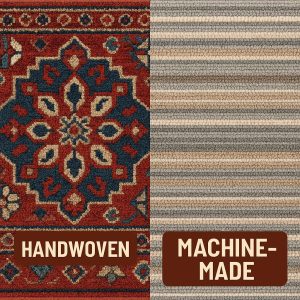
Handwoven Rugs
- Made by hand using natural fibres like wool, silk, or cotton, these items are often passed down through generations as family heirlooms.
- Each knot is tied individually, creating a unique pattern, texture, and character that tells a story of tradition and craftsmanship.
- Due to their intricate construction, they are fragile and require gentle cleaning with mild products and soft tools.
- Strong chemicals, rough scrubbing, or machine washing can permanently damage the fibres, causing fraying, colour bleeding, or loss of shape.
- Professional cleaning helps preserve their beauty and value for many years by using specialised methods, careful drying, and protective treatments to prevent future damage.
- Regular care, like vacuuming lightly and rotating the rug, can also extend its life and keep the design looking vibrant.
Machine-Made Rugs
- Created using machines, often with synthetic fibres like nylon or polyester, which makes them very consistent in quality and appearance.
- They are more affordable and better suited for high-traffic areas such as hallways, living rooms, and offices.
- Easier to clean at home because they can handle stronger treatments, vacuuming, and even steam cleaning in some cases.
- Available in a wide variety of designs, colours, and pile heights, they are versatile for many decorating styles.
- Even so, periodic professional cleaning helps maintain freshness, remove deeply embedded dirt, and keep colours bright and vibrant over time.
Common Carpet Cleaning Mistakes
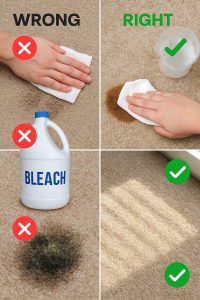 Many homeowners make simple mistakes that lead to damaged carpets. These errors can escalate minor issues into long-term problems, resulting in costly repairs or replacements. Here’s what to avoid and why:
Many homeowners make simple mistakes that lead to damaged carpets. These errors can escalate minor issues into long-term problems, resulting in costly repairs or replacements. Here’s what to avoid and why:
- Scrubbing too hard – this pushes the stain deeper, frays delicate fibres, and can cause rough patches that never fully recover.
- Using hot water causes stains to set permanently and can shrink natural fibres like wool, leaving the carpet misshapen and uneven.
- Using bleach or strong chemicals weakens fibres, causes fading or patchy colours, and may even destroy protective coatings on the carpet.
- Skipping proper drying can lead to mould, mildew, and unpleasant odours that are difficult to remove and can trigger allergies or respiratory issues.
- Over-wetting carpets can damage the backing, loosen adhesives, and create water stains or rippling.
- Over-wetting carpets during carpet cleaning can damage the backing, loosen adhesives, and create water stains or rippling.
- Neglecting regular maintenance – waiting too long between cleanings allows dirt to grind into fibres, shortening the life of the carpet.
By being aware of these mistakes and avoiding them, you can keep your rugs looking better for longer and save on costly repairs.
Safe Stain Removal Methods
Not all stains are created equal. Each type of stain requires a slightly different cleaning approach to avoid damage. Understanding the source of the stain helps you choose the correct cleaning method and prevent long-term harm to the fibres. Always act quickly when a spill occurs—speed is key to achieving the best results.
Implementing effective carpet cleaning methods can significantly enhance the longevity of your rugs.
Water-Based Stains (Juice, Coffee, Tea)
- Blot gently with a clean white cloth—never rub, as rubbing spreads the stain and pushes it deeper into the fibres.
- Mix a small amount of mild dish soap with lukewarm water to create a gentle cleaning solution.
- Dab the stain with the solution using light pressure, then rinse with clean water to remove soap residue. Choosing the right carpet cleaning solution is vital in preventing damage to your rugs.
- Blot dry with a clean towel and, if possible, use a fan to speed up drying and prevent mould.
- Repeat the process for stubborn stains, being careful not to over-wet the area.
- Example: Tea spilt on a wool rug should be treated with lukewarm water only, not hot water, to avoid shrinking. If the stain persists, sprinkle a little baking soda after drying to neutralise odours and absorb any remaining moisture.
Grease or Oil Stains
When treating grease stains, remember that quick carpet cleaning can prevent permanent damage.
- Sprinkle baking soda or cornstarch over the stain to absorb excess oil and gently press it in with a spoon to help it reach deeper into the fibres.
- Let it sit for at least 15 to 30 minutes, or longer for larger spills, then vacuum thoroughly to lift out the absorbed oil.
- Dab the area with mild detergent mixed with warm water using a clean cloth, working from the outside of the stain inward to prevent spreading.
- Repeat as needed and finish by blotting dry with a towel. For stubborn grease, use a small amount of white vinegar mixed with water as a follow-up step. A proactive approach to carpet cleaning includes regular inspections for stains and potential issues.
- Example: Cooking oil spilt on a polyester rug can be removed before it sets by using this step-by-step method, which helps prevent permanent marks and odours.
Ink or Marker Stains
For ink stains, effective carpet cleaning often requires a multi-step approach to ensure complete removal.
- Apply a small amount of rubbing alcohol using a cotton ball or soft white cloth to help lift the ink without spreading it.
- Dab gently and avoid oversaturating the area, as too much liquid can cause the stain to bleed or spread further.
- For stubborn ink, alternate between dabbing with alcohol and blotting with a dry cloth to slowly lift the stain.
- Always test a hidden spot first to ensure the colour doesn’t fade or react adversely with the cleaning solution.
- After cleaning, rinse lightly with a damp cloth to obliterate residue and blot dry.
- Example: Permanent marker on a nylon rug may fade if too much alcohol is applied, so work slowly and cautiously to preserve the rug’s colour. Using gentle methods is crucial in carpet cleaning to protect delicate fibres from further damage.
Pet Stains (Urine, Vomit)
- Blot with paper towels immediately to soak up as much liquid as possible, pressing firmly to absorb deep into the fibres. For pet stains, carpet cleaning should start with immediate action to prevent lasting odours.
- Rinse the area lightly with cool water to dilute it before applying the cleaner.
- Use an enzyme-based cleaner designed for carpets to break down the proteins in pet urine or vomit, which cause lingering odours and bacteria.
- Allow the cleaner to sit for several minutes as directed on the product label, then blot dry again with a clean towel.
- For recurring accidents, consider using a black light to locate hidden stains and treat them to prevent repeat soiling.
- Example: Cat urine on a cotton rug will leave a strong smell unless treated with enzymes that break down the scent molecules. Without treatment, the odour can attract pets to re-mark the same area, making the problem worse.
Deep Cleaning and Care Tips
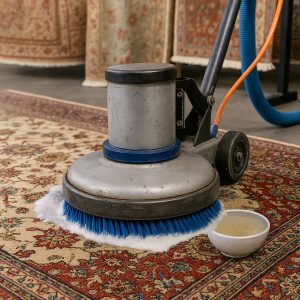 Regular care keeps your carpets looking new and prevents the build-up of dirt and allergens. In addition to day-to-day cleaning, there are steps you can take each month and season to keep your rugs in peak condition.
Regular care keeps your carpets looking new and prevents the build-up of dirt and allergens. In addition to day-to-day cleaning, there are steps you can take each month and season to keep your rugs in peak condition.
Incorporating regular carpet cleaning into your routine will help maintain a fresh home environment.
- Vacuum twice a week to remove surface dust and dirt. For high-traffic areas, consider vacuuming every other day.
- Rotate rugs every six months to distribute wear evenly, especially if furniture covers parts of the carpet or it sits in a sunny spot.
- Keep rugs out of direct sunlight to prevent fading and colour loss. If that’s not possible, use curtains or blinds during peak sun hours.
- Use rug pads underneath to prevent slipping, reduce friction, and add a layer of cushioning that protects the backing. Using rug pads can also be beneficial for maintaining cleanliness during carpet cleaning.
- Spot clean minor spills immediately, and use gentle cleaners to prevent residue build-up.
- Brush fringes or tassels by hand to prevent tangling and breakage.
- Deep clean once or twice a year, depending on the level of foot traffic. In households with pets or young children, seasonal deep cleaning may be necessary.
- After cleaning, ensure rugs dry completely before placing them back to prevent mould growth. After cleaning, ensuring your rugs are perfectly dry is essential to avoid mould growth.
- Example: Rotating a Persian handwoven rug prevents uneven fading caused by sun exposure through windows. Deep cleaning before the holiday season helps maintain its appearance when guests arrive.
Why Professional Cleaning Helps
Even with excellent home care, professional carpet cleaning provides a deeper, safer clean and offers benefits that at-home tools cannot achieve.
- Handwoven rugs: Require gentle, specialised techniques to avoid damage. Professionals understand how to clean intricate knots and natural fibres without causing colour bleeding or fraying.
- Machine-made rugs: They can withstand stronger cleaning, but professional tools still do a better job of removing deep dirt and restoring the original texture.
- Experts use high-powered equipment to remove embedded dirt, allergens, dust mites, and stubborn odours that home vacuums and spot cleaners cannot reach.
- Professional cleaners also have access to eco-friendly yet effective products that are safe for your family and pets while still being tough on stains. Engaging a professional service for carpet cleaning can yield superior results that home methods often fail to achieve.
- Example: After a flood or major spill, professionals can thoroughly dry rugs to prevent mould growth and structural damage that might compromise the backing.
- Routine professional care can help maintain warranty requirements for many modern carpets, adding value and peace of mind. Routine carpet cleaning by experts not only enhances aesthetics but also ensures the longevity of your rugs.
Professional cleaning not only makes your carpets look and smell fresh but also extends their life, keeping them soft, vibrant, and durable for many years to come. Regular visits—once or twice a year—ensure that hidden dirt and bacteria do not shorten the lifespan of your rugs.
Maintaining a regular carpet cleaning habit helps keep your home healthier for your family.
Hampstead Garment Care – Rug & Carpet Care Experts
At Hampstead Garment Care, we treat every rug with care, whether it’s a treasured family heirloom or a modern piece in a busy household. Our eco-friendly cleaning products are safe for your family, pets, and the environment, giving you peace of mind. We take the time to understand the unique needs of both natural and synthetic fibres and tailor our methods to each rug type, ensuring optimal results.
We also offer guidance on at-home maintenance between professional cleanings and provide advice on how to protect rugs from everyday wear and tear. With years of experience, our team has handled everything from antique Persian rugs to large commercial carpets.
 Why choose us:
Why choose us:
- ✔ Expert care for delicate handmade rugs and valuable heirlooms
- ✔ Safe and effective stain removal techniques that protect your rug’s fibres
- ✔ Convenient pick-up & delivery across London for hassle-free service
- ✔ Eco-friendly cleaning for a healthier home and environment
- ✔ Specialised drying to prevent mould, mildew, and long-term damage
- ✔ Personalised care plans for regular clients and commercial spaces. Understanding the significance of carpet cleaning will help you make informed decisions for your home.
Conclusion: The Importance of Carpet Cleaning
Your rugs and carpets are more than floor coverings—they are investments and part of your home’s style. By learning how to identify fibres, avoiding common mistakes, and knowing when to call a professional for carpet cleaning, you can protect their beauty and extend their lifespan. Whether you need help with a stubborn stain or want to clean a valuable handwoven rug deeply, Hampstead Garment Care is here to help with our expert carpet cleaning services.
Ready to bring your rugs back to life? Book your carpet cleaning today.


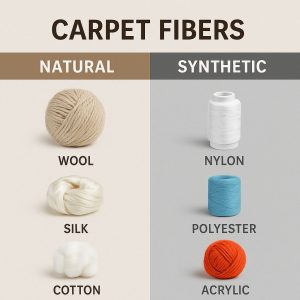
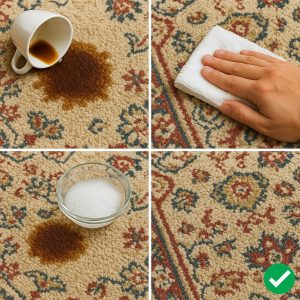


No comment